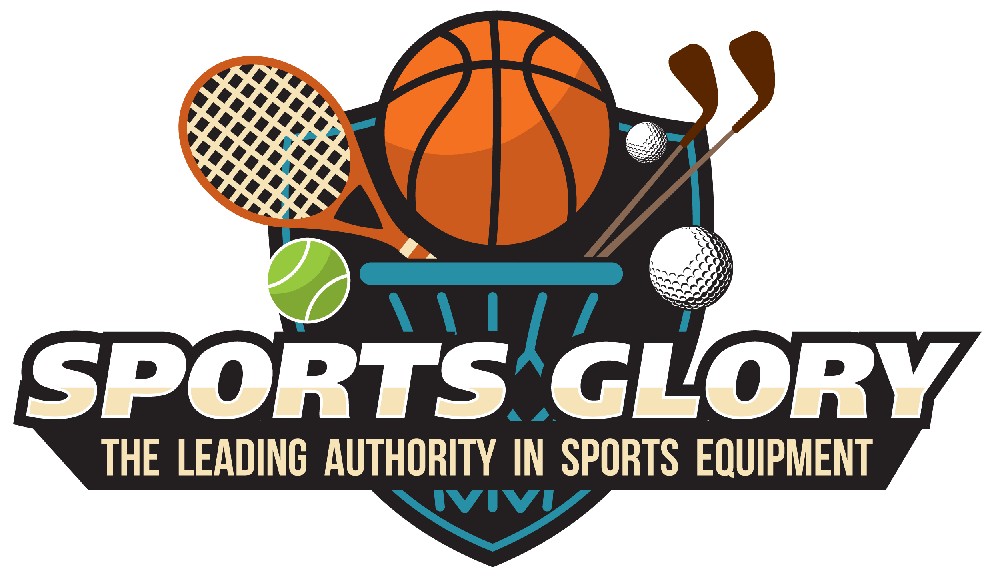In our mini-guide, we’ll go over some of the key features to look for and then give you our recommendations for the best soccer rebounders for 2024!
In our full-guide below, we’ll go more in-depth on what to look for when choosing a rebounder. We’ll also show you or your child can get the most out of your new purchase and how to train the skills to get you on the road to the cup final.
Contents
- What’s the Difference Between Different Types of Soccer Rebounders?
- Top 10 Best Soccer Rebounders 2024
- 1. Best Overall Soccer Rebounder: SKLZ Quickster Soccer Trainer
- 2. Most Versatile: Boulder Portable Badminton Net Set
- 3. Best Premium Soccer Rebounder: Tekk Trainer Rebounder Goal
- 4. Best Multi-Task Rebounder: Champion Sports BN4272
- 5. Best Budget Soccer Rebounder: Franklin Sports Adjustable
- 6. Most Portable: NET PLAYZ Easy Fold Up Portable Training Soccer Goal
- 7. Best Choice for Kids: Franklin Sports Competition Soccer Goal
- 8. Strongest Net: Rukket Barricade Backstop Net
- 9. Most Compact: RUNNZER Portable Soccer Goal
- 10. Best for Shooting Drills: QuickPlay PRO Soccer Goal Target Nets
- How to Choose the Best Soccer Rebounder
- How to Use Your New Soccer Rebounder
- Final Word
What’s the Difference Between Different Types of Soccer Rebounders?
There are three types of soccer rebounders that you will come across as you start searching for the best fit for you. Two are specialized to target a particular set of skills while the third is a bit more all-purpose and can often be used for other sports aside from soccer. Here’s a quick breakdown of the differences between the three types:
Passing and Ball Control Soccer Rebounder
As you might guess from the name, a passing and ball control soccer rebounder helps you develop your passing and ball control skills. It typically features a smaller net and frame that are positioned low to the ground.
Some of these, like the Rukket Barricade Backstop Net stand straight upright, while others, like the Champion Sports BN4272 Rebound Pitchback Net lean back. In either case, the purpose is to provide you with a small surface area to kick the ball into.
As they’re small, you have to improve your ball control to consistently hit the target. By being lower to the ground, the rebound of the ball back toward you more closely mimics the angle at which a ball would come at you if it had been passed to you by another player.
Striking Rebounder
Striking rebounders tend to be larger than the passing and ball control type. This is because it is meant to help you improve your goal scoring technique so you need to be able to kick the ball at the same angles and toward the same points in space that you would be aiming for when you’re going for the goal in an actual game.
However, just because they are designed for improving your striking technique doesn’t mean they are all regulation size. In fact, you can find striking rebounders in a wide variety of sizes, tailored to the needs of both children and adults.
Some striking rebounders, like the QuickPlay PRO Soccer Goal Target Nets with 7 Scoring Zones, even include designated areas, marked by a pocket or a different color net that allow you to significantly improve your accuracy and start strategically taking shots at the parts of the goal that are most difficult for the goalkeeper to block.
Multi-Task Soccer Rebounder
If a soccer rebounder is designated as multi-task this either means that it can be used for all of the skills targeted by the previous two types or that it can be used for a variety of sports. Sometimes, it means both.
In addition to passing, ball control, and striking, the multi-task type is also good for practicing secondary skills like throwing, heading, and so on.
These are a great choice if you know you need versatility, or you want to be able to work on all your techniques without cluttering up the backyard with a bunch of nets. If you come from a multi-sport family, a multi-task rebounder is a good way to meet everybody’s needs.
A single net can help you hone your striking accuracy while helping your kid perfect their softball pitch. Some nets can even be adjusted to meet different needs and used for games like badminton, tennis, or volleyball when you aren’t busy running soccer drills.
This set is a great example of the kind of multi-purpose functionality you can find in this category.
While this may seem like a lot to take in, it will be easier to make sense of after you browse through a few of the most popular options on the market. Take a look at our top 10 picks for best soccer rebounders for 2024 below:
Top 10 Best Soccer Rebounders 2024
1. Best Overall Soccer Rebounder: SKLZ Quickster Soccer Trainer
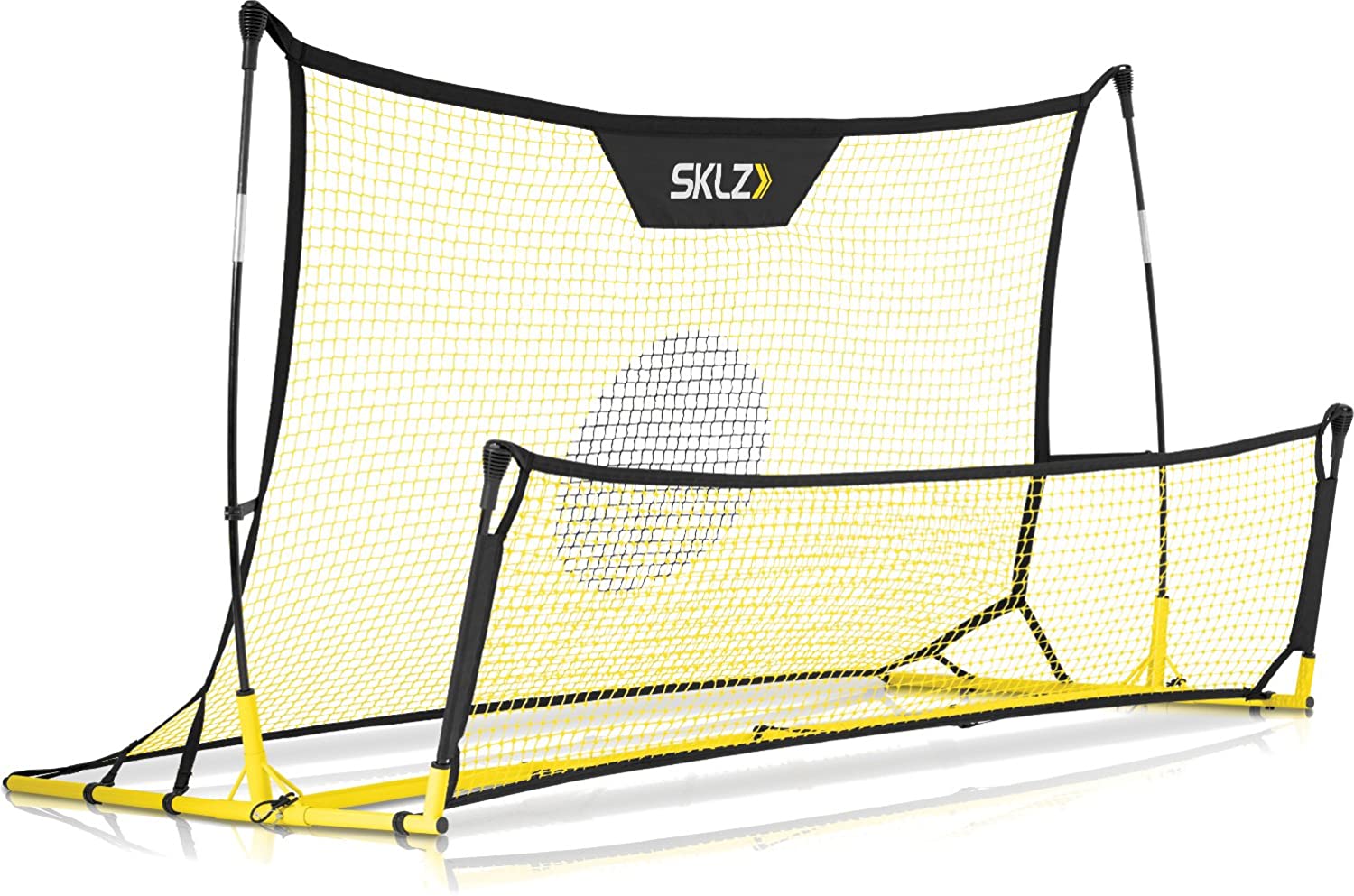
Editor’s Rating:
Quick Facts
- Type: Multi-task rebounder
- Size: 8’ x 7’
- Set Up Time: N/A
Review
This multi-task rebounder is extremely versatile, very well-built, and portable. At the middle of the price spectrum, it’s not the cheapest – but we think the versatility and quality make it an excellent choice for players of all skill levels.
Construction
In terms of build, what stands out most about this rebounder is how the manufacturers managed to work in high-quality materials without adding too much extra weight. A durable, heavy-duty frame lies on the ground and supports the more flexible fiberglass poles that hold up the net.
The nylon net is supported by strong, nylon borders and while the stitching could use some reinforcement, the material itself is very sturdy. For a net that also boasts strong stitching, consider the Rukket Barricade Backstop Net.
Skill Focus
The most unique feature of this rebounder is the dual net design. One net is larger and features a ring of black netting in the middle that acts as a target. This side is meant for working on your shooting accuracy, volleying, and throwing.
The smaller net on the other side is angled slightly downward to help you work on passing, receiving, and ball control. By having two nets, each one can be uniquely tailored to the specific skills it’s designed to help with.
- Unique dual-net design for a full range of drills
- Durable yet lightweight construction
- Portable
- Weak stitching around the borders may need to be reinforced
2. Most Versatile: Boulder Portable Badminton Net Set
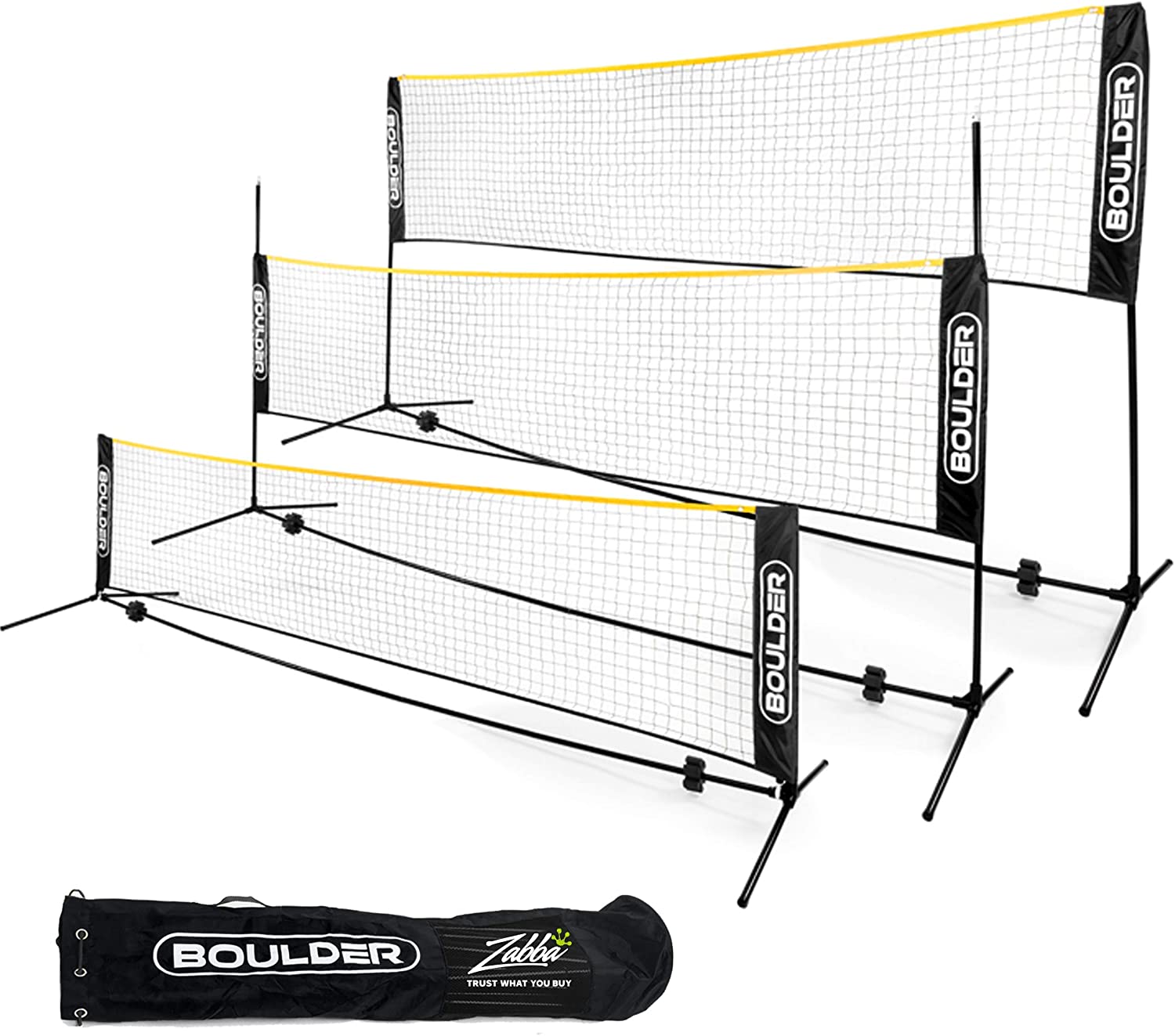
Editor’s Rating:
Quick Facts
- Type: Multi-task
- Size: 2.5’ x 10’ (other widths available)
- Set Up Time: 3-5 minutes
Review
This multi-task soccer rebounder is both well-built and versatile. You can use it for any soccer drills you want to do. Then, when you’re done practicing, wind down with a game of badminton or place it over the pool for a game of water volleyball.
Construction
The construction of this net is where it really stands out. For a portable, easy set-up net, it is surprisingly heavy duty. The net is made of a dense, tear-resistant nylon that is securely stitched into the thick nylon seams on either end. The bands along the top and bottom also help prevent tears and create the tension needed for a highly responsive net.
The poles are very solid and sturdy as they are made out of heavy-duty steel alloy. While the paint coating on the poles will likely chip away, the structure itself will remain stable and reliable for a long time.
The trade-off for this long-lasting construction is its substantial weight. Lugging this out onto the field will not be as easy as some of the lighter models, yet the quality you get as a result makes it worth considering.
If a lightweight design is one of your top priorities, however, you might be better off with the NET PLAYZ Easy Fold Up Portable Training Soccer Goal.
Skill Focus
This is primarily designed as a badminton net. However, because of the adjustable height and the high responsiveness of the net, it makes an excellent soccer rebounder.
You can use it to run a variety of different drills. Adjust it down to the ground to work on your passing and ball control. Then, adjust it up to the middle or top height to practice striking, accuracy, and volleying.
If you only plan to use it for running soccer drills, the 10-foot net is more than enough to do the job. The only reason to go for any of the wider options is if you also plan to use it for other sports like badminton, volleyball, or tennis.
- Sturdy, long-lasting nylon net
- Durable, rust-resistant frame
- Adjustable height
- Suitable for a wide variety of sports
- Heavier than other portable models
- It’s not primarily intended for soccer
3. Best Premium Soccer Rebounder: Tekk Trainer Rebounder Goal
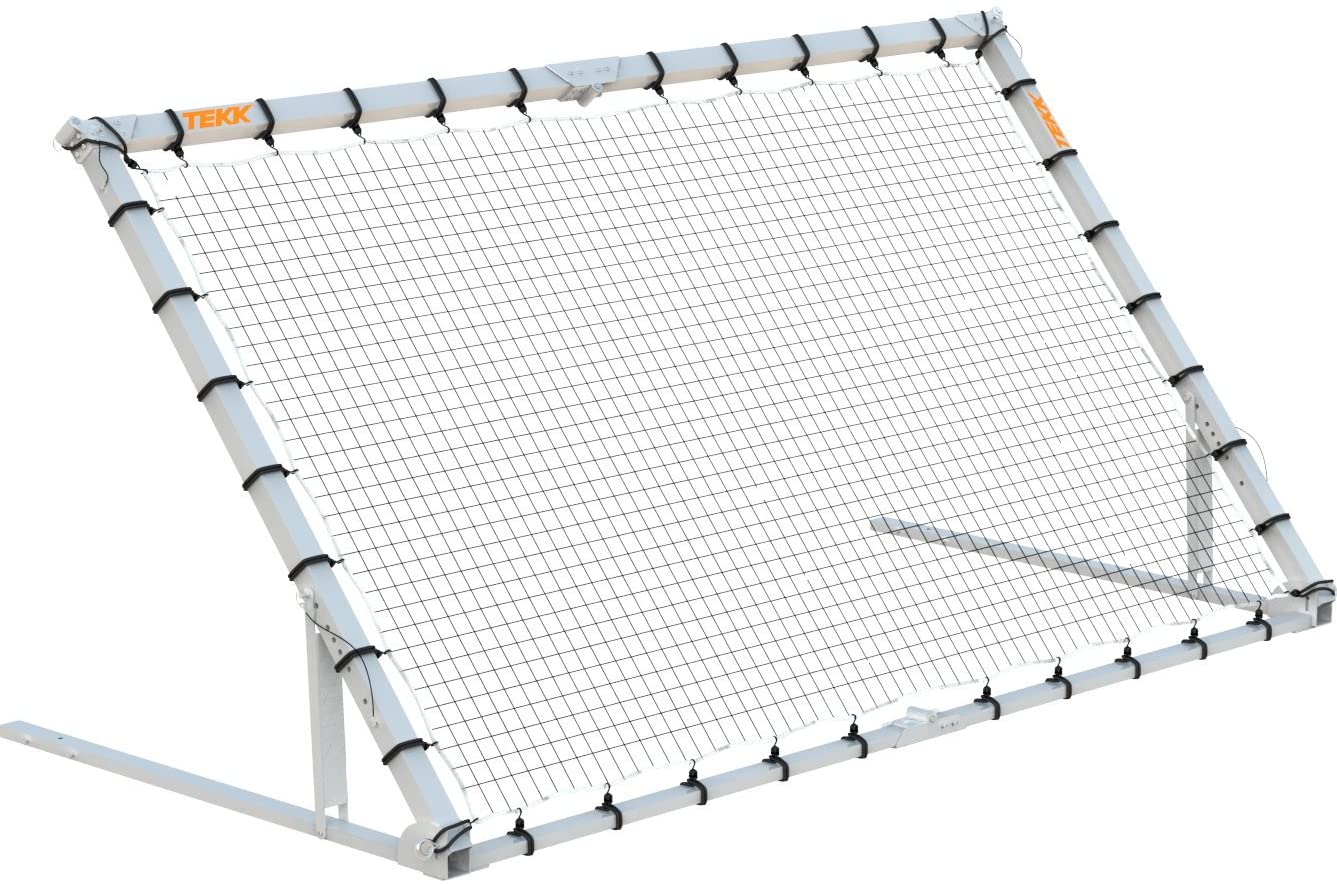
Editor’s Rating:
Quick Facts
- Type: Multi-Task
- Size: 5’ x 8’
- Set Up Time: 2 minutes
Review
The heavy-duty frame and super strong net puts the Tekk Trainer in a class of its own when it comes to quality. It’s expensive, so it is definitely an investment. However, for coaches or advanced players, it’s one worth considering.
Construction
This rebounder truly offers premium quality. The frame is made from thick steel and aircraft-grade aluminum. Both the brackets and the tubing are powder coated to prevent rust. The net is made from 45 ply polyester and mounts to the frame via bungee hooks.
This all gives it incredible quality. However, in terms of portability, it’s a mixed bag. It does set up and tear down easy, and you’ll have it up and ready to go in under two minutes. But it also weighs 40 pounds and it doesn’t come with a carrying bag.
So, even though it is technically portable, we’d recommend using this either as a permanent rebounder or making sure that you don’t have to carry it very far if you do want to transport it.
If you’d prefer something more lightweight, consider the NET PLAYZ Easy Fold Up Portable Training Soccer Goal.
Skill Focus
Due to the adjustable frame, you can use this for any drill. Angle it back for volleys or passing drills. Bring it back up to do some shooting practice. Then, turn it around to use as a goal for scrimmage.
- Incredibly high-quality frame
- Strong, tear-resistant net
- Sets up in under two minutes
- Adjustable angles
- Too heavy to carry long distances
4. Best Multi-Task Rebounder: Champion Sports BN4272
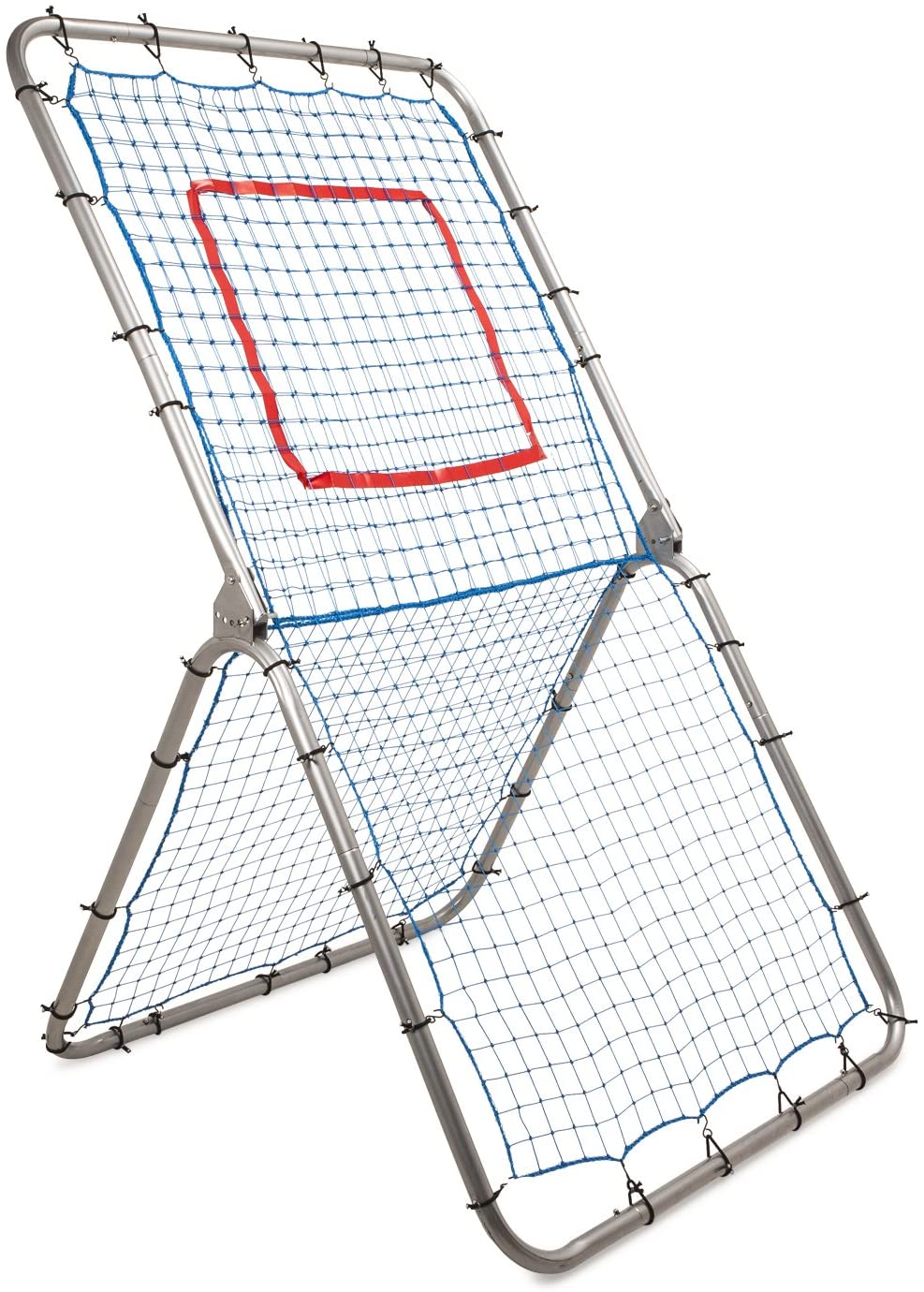
Editor’s Rating:
Quick Facts
- Type: Multi-Task
- Size: 3.5’ x 6’
- Set Up Time: 3-5 minutes
Review
This multi-sport rebounder is a great choice for households with athletes of all different sports. It’s also a good pick for a soccer player who wants something they can practice all the important skills on.
Construction
The powder-coated steel frame is remarkable. It’s built to withstand the repeated beating it will get from soccer players, softball players and every other athlete who can use this multi-purpose net.
The net, unfortunately, is not as impressive. While it is still made of durable nylon material, it isn’t put together as well as some others we have seen on the market. You might experience some tearing early on. We do like the red striping that marks out a target zone, though.
The biggest drawback of this design is that it does not fold down as small as other portable rebounders. If your car is limited on trunk space, it might not fit. For something that folds down into a smaller, easier to transport size, consider the RUNNZER Portable Soccer Goal.
Skill Focus
The design allows you to use this as any kind of rebounder you want. Players of all positions on the field, including the goalkeeper, can use it. Use the shorter side for passing and ball control drills. Then, use the tall side for shooting practice and accuracy.
Goalkeepers can use the upper end of the tall side for throwing practice. Because of the angle, you can use the lower part of the tall side for passing and ball control as well. That also means you can put two players on one rebounder at the same time.
- Versatile, all-purpose rebounder for every player on the team
- Clearly marked target zone
- Dual-side design
- Sturdy frame
- When folded down, this is not as compact as other portable models
- Somewhat flimsy net
5. Best Budget Soccer Rebounder: Franklin Sports Adjustable
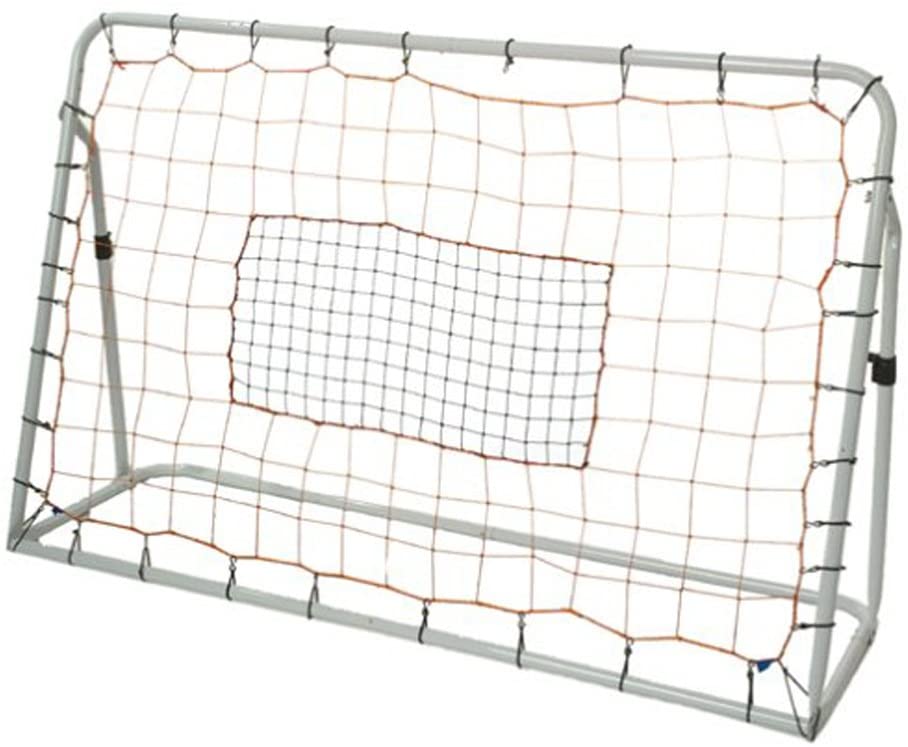
Editor’s Rating:
Quick Facts
- Type: Multi-task rebounder
- Size: 6’ x 4’
- Set Up Time: 30 minutes
Review
This small rebounder is ideal for shooting practice due to the large-webbed net and the designated target at the center. Plus, the frame is solid enough that you won’t need to pin this down with stakes to keep it in place.
Construction
The 100% steel frame is probably the biggest selling point on this rebounder. Not only is it durable, it’s also heavy-duty enough to withstand the repeated shock of having soccer balls kicked at it.
The net, on the other hand, leaves something to be desired. Sure, the design is very cool, and the easy snap-on closures that attach it to the frame mean you can take it down when not in use, helping you to protect it from the elements and extend its life.
However, the construction of the net is a little flimsy and prone to tears. Because of those convenient snap closures and the thin webbing, it’s also not something you can easily fix with extra stitching.
While this is easy to set up, it still takes about 30 minutes to put it together. At 19 pounds, it’s also heavy. So, this is definitely something you get for a permanent set up in your backyard. It’s not very portable. If you want something that sets up easier, consider the Boulder Portable Badminton Net Set.
Skill Focus
The adjustable angle of the frame means you can use this to run a variety of drills. It’s mainly designed for shooting practice but if you angle it back, you can practice volleys, passing, or even throwing accuracy.
- Heavy-duty 100% steel frame
- Adjustable angles for a variety of drills
- Compact design ideal for small backyards
- Somewhat flimsy net
- Too heavy to be portable
6. Most Portable: NET PLAYZ Easy Fold Up Portable Training Soccer Goal
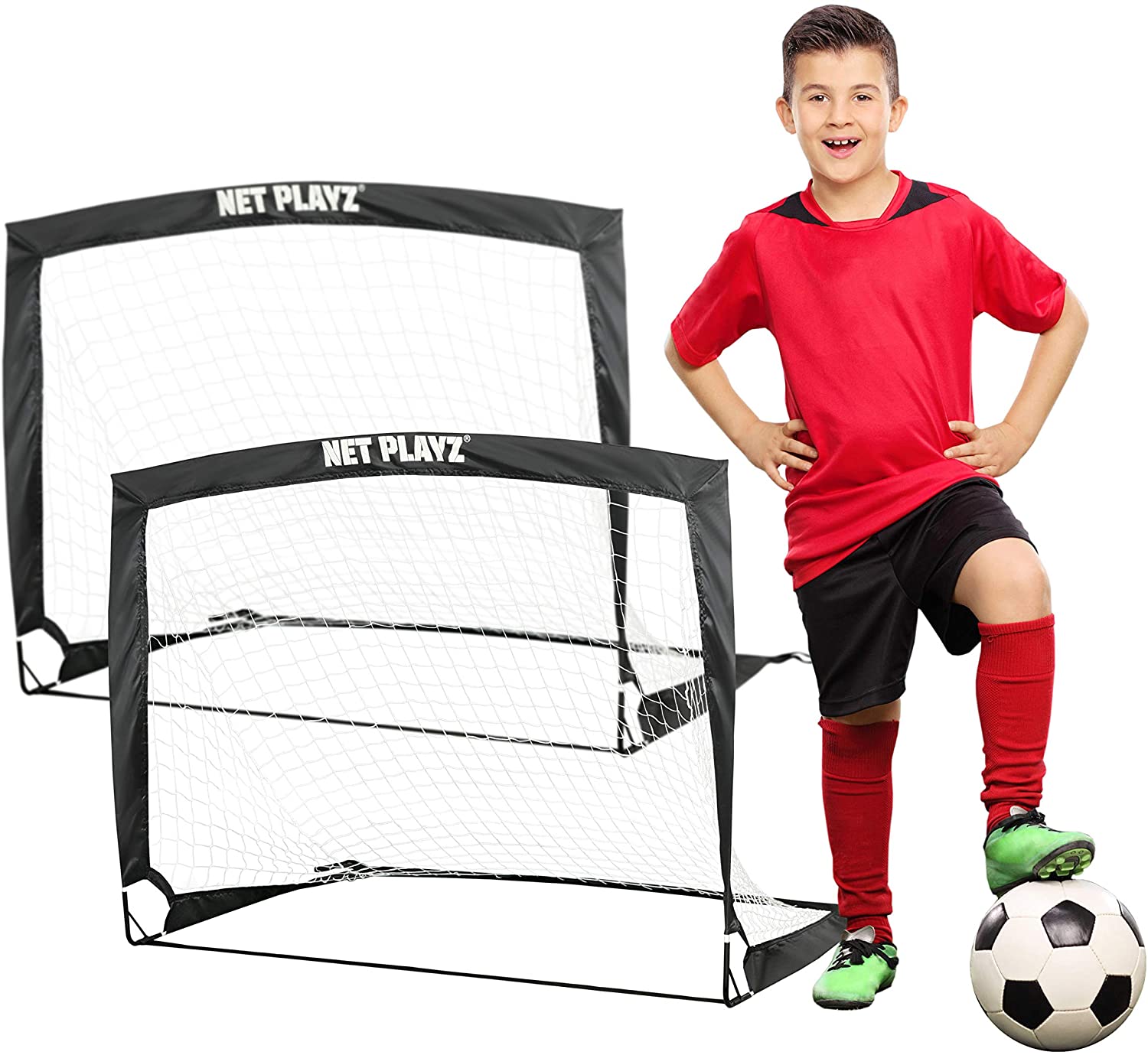
Editor’s Rating:
Quick Facts
- Type: Striking Rebounder
- Size: 4’ x 3’
- Set Up Time: Under 30 seconds
Review
This set of two rebounders is perfect for players of all ages and they make an especially good choice for coaches. You can get a few sets to work with without breaking the bank and thus have enough portable rebounders to allow your entire team to work on their drills without having to wait and take turns.
Construction
The net is very well designed on this rebounder. It is a looser web, but that is what you want to look for in a striking rebounder. The thick, nylon border is what really makes it a good net, though. This holds it securely in place on the frame.
The frame, however, is on the flimsier side, as it needs to be lighter and more bendable to give you that convenient collapsibility. You can pop it up and fold it down in a matter of seconds, so it is one of the best choices if portability is your main concern.
The set also includes eight stakes that you can use to pin the frame to the ground. You will almost certainly want to use them. The frame is so lightweight that, unless you use the spikes, any ferocious shot will knock it down.
Skill Focus
These are true striking rebounders. The looser, less responsive net is ideal for shooting practice. Because of the way it is built, you can use it as a small goal as well as a rebounder. Plus, its size is exactly what children under eight will see on the field, making it a great choice for kids.
- Super lightweight construction
- Collapsible frame for easy set up and tear down
- Includes stakes for added stability
- Suitable for kids
- Not the most durable frame
- an’t use it for passing drills
7. Best Choice for Kids: Franklin Sports Competition Soccer Goal
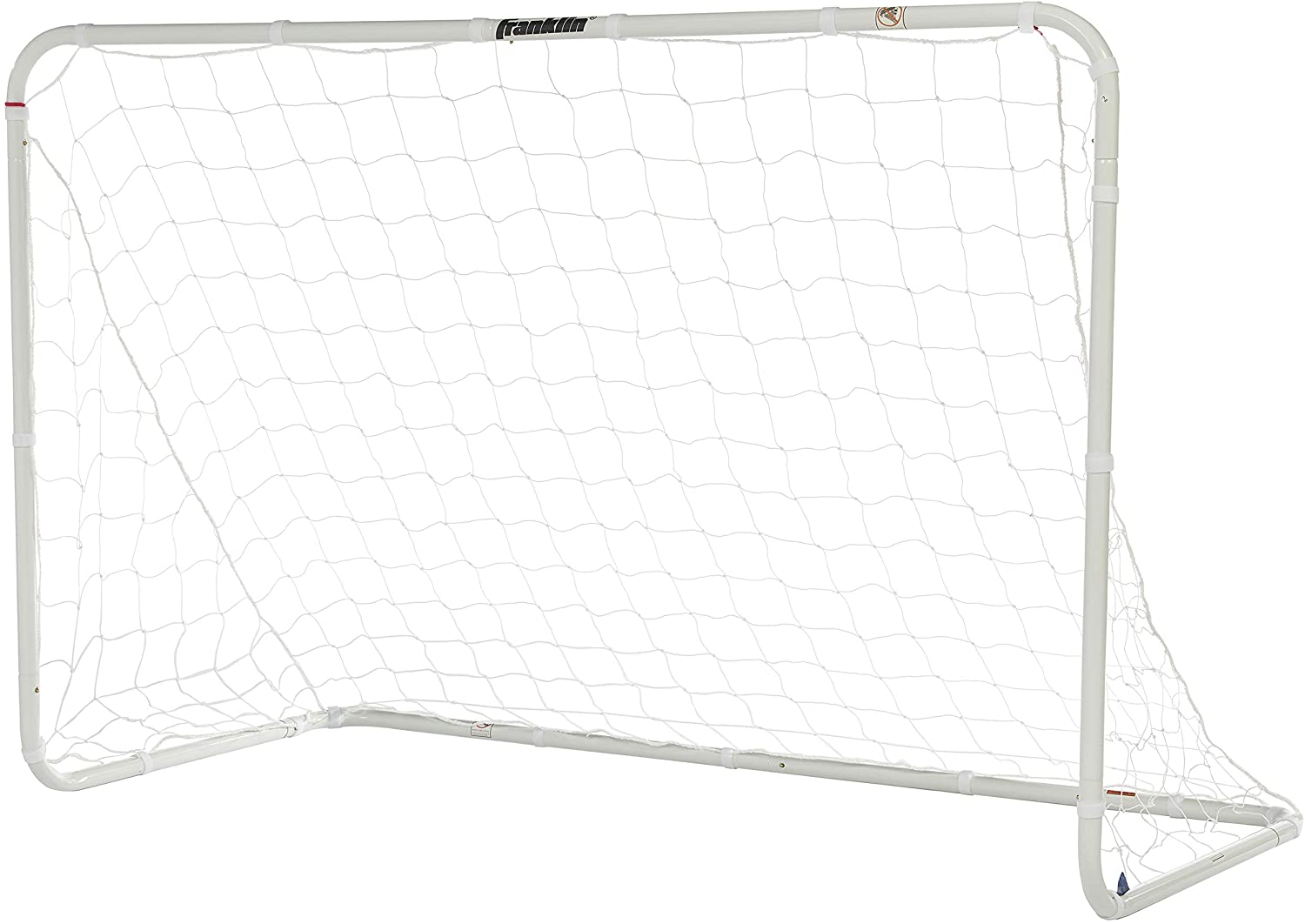
Editor’s Rating:
Quick Facts
- Type: Striking Rebounder
- Size: 12’ x 6’
- Set Up Time: N/A
Review
This portable striking rebounder is a reliable piece of equipment for either the coach of a young team or the parents of a budding young soccer player. It also comes in a range of sizes, so you can upgrade the size as your child advances into higher age groups.
Construction
The most notable features of the construction are its lightweight design, rust resistance, and ease of set up. Despite the fact it’s lightweight, the frame is still made with galvanized steel so it’s surprisingly durable. It also comes with four stakes to secure the frame to the ground, so it won’t topple over as soon as you kick a ball into it.
The biggest drawback on this rebounder is probably the use of Velcro to secure the net to the frame. It does make it easier to put on and take off. However, for teens and adults who can pack some power behind their kick, the Velcro may not hold up, which can get frustrating.
So, this is better for younger children who don’t have a strong enough kick to undo the Velcro clasps. For a more securely attached net, consider the Tekk Trainer Rebounder Goalf.
Skill Focus
This rebounder doubles as a goal, making it convenient for team practices. You can also use the sides of the goal as a narrow rebounder to work on accuracy. The back of the goal works great for running shooting or throwing drills.
- Durable yet lightweight steel frame
- Works as both a goal and a striking rebounder
- Fast and easy set up and tear down
- Velcro closures may not be strong enough for more advanced players
8. Strongest Net: Rukket Barricade Backstop Net
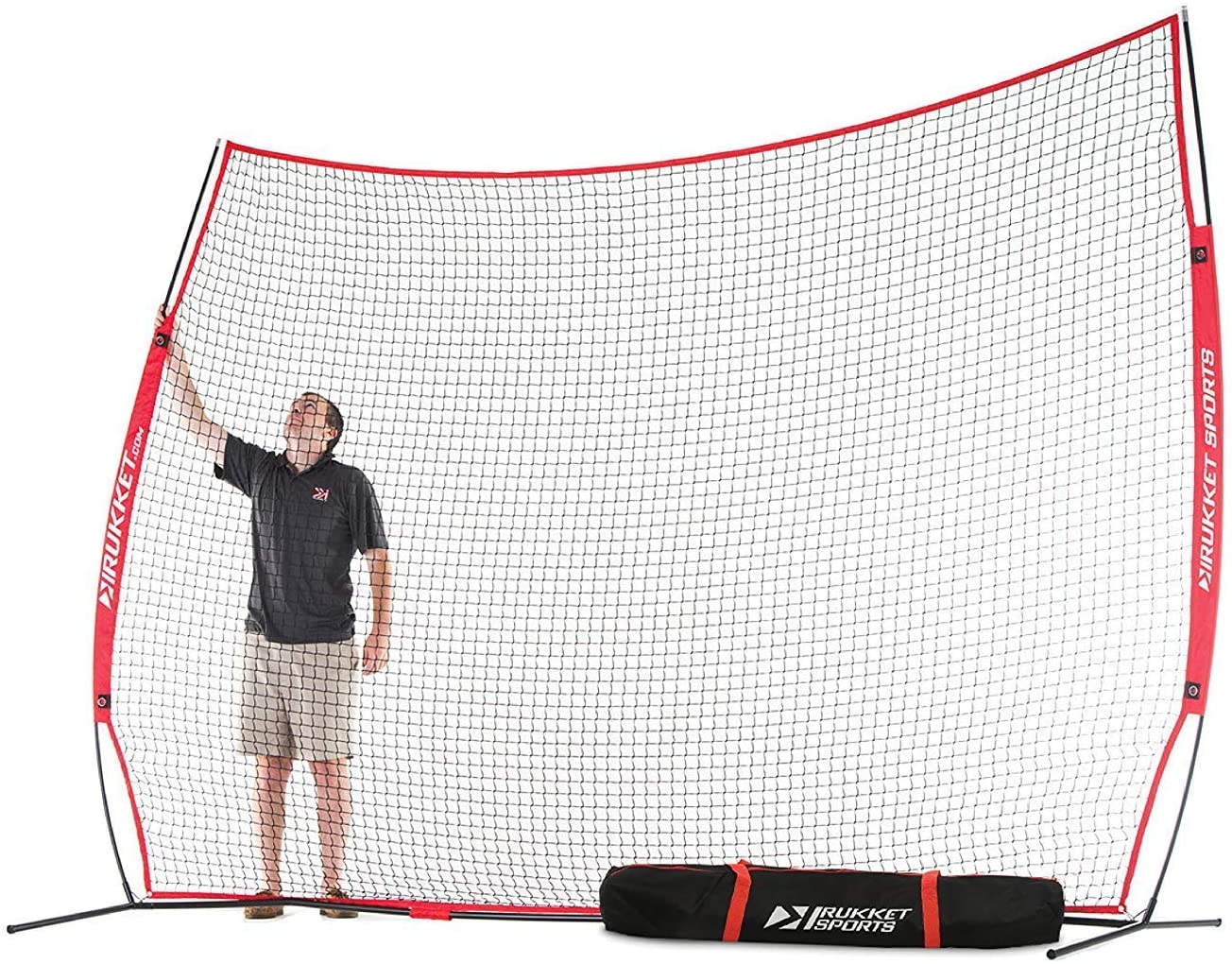
Editor’s Rating:
Quick Facts
- Type: Striking Rebounder
- Size: 12’ x 9’
- Set Up Time: 3-5 minutes
Review
Standing at 12’ x 9’, this is one of the largest rebounders on the market and, surprisingly, it’s still portable. It’s very well built and designed to be used by a variety of athletes so it’s a good pick for multi-sport families.
Construction
Given that this rebounder is mostly net, it’s good to see that the net is so high quality. It’s made from 7-ply knotless polyester and a double layer border that is securely stitched on so tears are unlikely to be a problem.
The fiberglass poles are a little less impressive than the net but still very durable. Because they are made from a more pliable material, they are less likely to dent. They can bend to absorb the shock of the impact without losing their shape.
Skill Focus
The large size makes it a great striking rebounder, but it also acts as a protective barrier. The soccer player of your family would have to try really hard to miss this net. You can place it in the backyard and not have to worry about balls ending up in the neighbor’s yard or, worse, their window.
The biggest drawback of this rebounder is that it’s not adjustable. You can’t angle it forward or backward. So, you’re a little limited if you want to work on passing or ball control. For that, you might be better off with the Franklin Sports Adjustable Soccer Rebounder.
- Large area great for shooting and throwing drills
- Exceptionally high-quality net with solid stitching and construction
- Lightweight
- Collapsible design for easy set up and tear down
- Not adjustable
9. Most Compact: RUNNZER Portable Soccer Goal
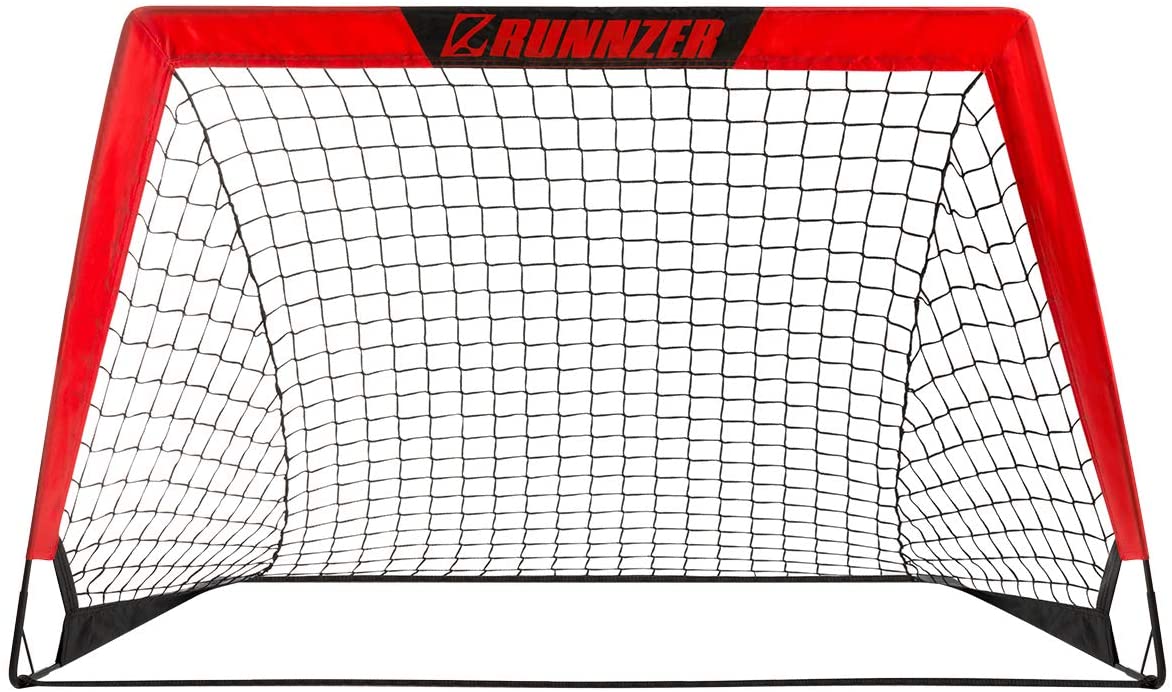
Editor’s Rating:
Quick Facts
- Type: Striking rebounder
- Size: 2.5’ x 4.5’
- Set Up Time: 30 seconds
Review
At just 2 ½ pounds, this is one of the lightest and most compact striking rebounders you can find. The pop-up design allows you to set this up in seconds and get right into practicing in no time. It’s most suited for children or beginner players.
Construction
The oxford fabric net is surprisingly strong given the price point. You usually expect to get a flimsier net at this price, but this one is made of a strong mesh that is securely stitched to a thick, heavy-duty border.
The fiberglass frame helps make this rebounder incredibly lightweight and easy to fold up and down, making portability one of the strengths of this product. That light weight and convenience does come at a cost, though.
Not only is this less durable than heavier frames, but it’s also liable to topple over from the impact of soccer balls. There are four stakes included so that you can stabilize it, but the J shape of the stakes does not offer as much stability as a full horseshoe stake would. As such, you might want to buy better stakes separately.
For something with similar portability but better stakes to secure it to the ground, you might prefer the NET PLAYZ Easy Fold Up Portable Training Soccer Goal.
Skill Focus
This striking rebounder works as both a rebounder and a goal, so it is pretty versatile. However, the net is not really responsive enough to do passing or ball control drills. However, the looser structure does help improve your accuracy because it allows you to see what you’re hitting with your shots.
This is a good choice for young children or for beginner players looking for something affordable to improve their accuracy and shooting skills.
- Super easy pop-up design for instant set up and take down
- Folds down very small for easy carrying
- Weighs less than 3 pounds
- Lack of stability in the frame
- Cheap stakes that don’t help much to increase stability
10. Best for Shooting Drills: QuickPlay PRO Soccer Goal Target Nets
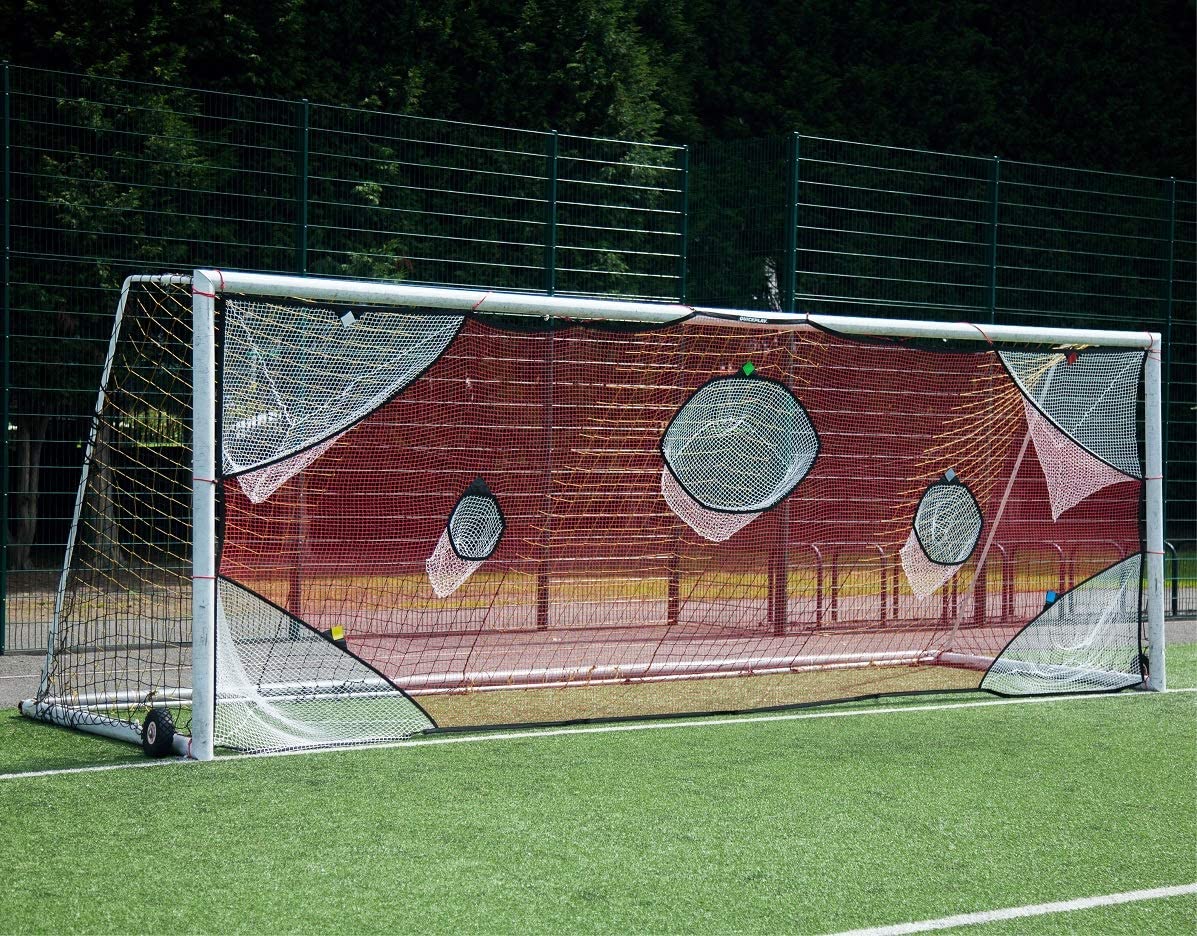
Editor’s Rating:
Quick Facts
- Type: Striking Rebounder
- Size: 6.5’x9.8’
- Set Up Time: 2 minutes
Review
This target net fits a regulation size goal and is tailor-made to help players improve accuracy. It’s uniquely designed to focus on seven specific scoring zones within the goal where strikers are most likely to be able to sneak the ball past the goalkeeper.
Construction
This rebounder is made of very thick and durable netting and super-strong nylon border with secure stitching. It was definitely built to last. The metal bungee hooks that mount this to the goalposts make it easy to set up but also strong enough to withstand the impact of soccer balls being lobbed into it.
The biggest drawback is that you are just getting the net itself. While it does come in four different sizes – including the regulation goal size – that does mean you have to provide your own goalposts to mount it to. If you’re serious about your training and already have goal posts set up, or easy access to them, then this is suitable for you.
Skill Focus
This is the ideal net for anyone who plays a forward or midfielder position. With the pockets located in the seven scoring zones, you’ll be able to improve both accuracy and strategy in your offensive game.
With that said, this net is definitely for more advanced players. Young children and beginners may be better off with something that helps develop a wider range of skills like the SKLZ Quickster Soccer Trainer Portable Soccer Rebounder Net.
- Features 7 pockets located in key scoring zones
- Durable, high-quality net construction
- Strong bungee hooks for easy set up and tear down
- As a standalone net, you would need to buy a separate frame to use this in your backyard
How to Choose the Best Soccer Rebounder
The basic features of a soccer rebounder might seem pretty straightforward, but quality and construction are everything when it comes to picking out the best one for your needs. Some are made to be portable, while others are made to be permanently fixed in one place. Some are meant for children, while others are meant for adults.
Therefore, what looks straightforward from the outset actually turns out to require a little more consideration than you might have thought. Let’s take a quick look at some of the key features you will need to consider as you shop for your next soccer rebounder.
Important Factors in a Net
The net might just be the most important feature of a rebounder. Other features are important, but while you can still use a good net on a bad frame, you will have less luck with a bad net on a good frame.
The net is what gives your rebounder that bounciness. In order to handle the constant tugging and pulling of a ball being kicked into it at high velocity, the net needs to be high quality. Above all, it needs to be able to take that beating without losing its shape or tearing right off the frame.
Knit and Density
In terms of construction, it should be fairly tightly knit with holes that are obviously not larger than the soccer ball. The smaller the holes, the denser the net. This higher density generally translates to a longer lifespan.
The size of the holes also tells you something about the rebounder’s purpose. A tight-knit net is generally found on passing and ball control rebounders. You need that high responsiveness to mimic the ball being passed at you with speed, and to help you practice your control.
Looser-knit nets, on the other hand, are usually found on striking rebounders. That give in the net slows the ball down, giving you time to see where you aimed it. It also lets you get a good read on the speed the ball was going based on how strong the impact on the net was.
UV Protection
For rebounders that will be standing permanently in place in your yard, look for a net that is UV resistant. This will prevent the netting from fading, but more importantly, it will stop it becoming brittle as a result of sun damage.
Stitching
You also want to pay attention to the stitching around the edges where the net attaches to the frame. Stronger stitching will prevent tears and other issues.
However, if the net itself is high quality enough, and you like everything else about the rebounder but the stitching is weak, it might still be worth buying. If you’ve got a sewing machine on hand, weak stitching can be reinforced in a matter of minutes.
Important Factors in a Frame
The frame of your rebounder will determine how long it will last, how much punishment it can take, how easy it is to set up and take down, and its portability.
Permanence vs. Portability
If you want a high-quality of your rebounder, you probably need to look at a more permanent structure like this one. Because they are designed to stay up for the long term without being moved around, manufacturers can use heavier duty materials that are more durable.
However, if you need something you can set up and tear down in minutes because you’re taking this to and from practices, you’ll probably have to accept a slightly flimsier frame in exchange for that kind of quick collapsibility.
To make something lightweight and foldable, manufacturers just can’t use the same kind of materials or the same density of materials. With that said, there are some impressively high-quality options in the portable rebounder space. This one is an example of something collapsible that uses a unique frame construction to provide something more durable but still convenient.
Durability
Regardless of whether you opt for portability or permanence, expect your frame to take a beating. You and whoever else is practicing with this rebounder is literally pelting soccer balls directly at it at full force. If the frame is too light or flimsy, it might not be able to absorb this repeated shock for very long.
If you have a really lightweight rebounder for portability reasons, consider using stakes to pin it to the ground. This will prevent your rebounder from knocking over with every kick.
Size
Soccer rebounders come in a wide range of sizes to meet the needs of players of different ages or skill levels. The size you choose depends on a few different factors. Above all, it depends on what skill you are hoping to target. The age of the user should also be taken into account.
Skill Focus
To improve accuracy, passing, or ball control, you want to look at a smaller option like this one. The smaller size requires higher accuracy. Because they are generally lower to the ground, it also is better for practicing giving and receiving passes even when you’re training by yourself.
To improve strength, throwing, or striking, you want to look at a larger option like this one. These larger rebounders tend to be closer to a regulation size goal allowing you to focus on targeting specific parts of that goal area and improving your ability to maneuver the ball around the goalkeeper in a real match.
Age
If you are looking for something for children around 10 or younger, go for a smaller one like this one. It is close to the size of the smaller goals they will see on the playing field.
If the rebounder will be used by somebody over the age of about 10 to 12 years, go for a medium to large size to make sure they are practicing their targeting on something that closely matches the dimensions of the larger, regulation size goals they’ll be encountering during actual matches.
Skill Focus vs. Age
In some cases, it might seem like the two criteria conflict. Maybe you have an 8-year-old who really wants to work on their striking. Their age would dictate opting for a smaller rebounder, but their skill focus would dictate a larger one.
For a situation like this, you might look for a middle ground by getting a medium-sized rebounder. Otherwise, let the skill focus take priority, especially if you are reasonably sure your 8-year-old will stick to the game at least into their teens. They can grow into a larger rebounder.
What Is the Best Soccer Rebounder for Kids?
The general answer is a smaller and more versatile one. The standard goal size for youth soccer is between 4’x6’ and 7’x21’. You can find the specific goal sizes by age group here.
Getting something that is the same size as the goal they will see on the field can help them hone their skill to that specific size.
Regarding versatility, a younger player is probably also a newer player. This means they could probably benefit from practicing all the important skills needed in soccer. Getting a multi-task rebounder allows kids to use any training drills they like and get a well-rounded practice session in, all with one piece of equipment.
If your child is on the cusp of an age group, you’d probably be better off sizing up to the goal dimensions of the next age group up. They might as well start practicing with the larger goal size now so that they’re already comfortable with it by the time they get moved to the larger field.
What Is the Best Soccer Rebounder for Teens and Adults?
Older age groups tend to need larger rebounders that are either the exact dimensions of the goal they use in matches or as close to it as possible. However, for more experienced players, you also have to factor in which skills you’re focusing on.
For example, an adult who wants to work specifically on their passing technique might be better off with a smaller goal like this one that allows them to practice this skill specifically.
Can You Make a Soccer Rebounder?
The short answer: yes. You will find no shortage of tutorials online for building your own DIY soccer rebounder. The problem, however, comes with quality and features. Most of these tutorials show you how to build a rebounder using plywood or other utility lumber.
This is pretty flimsy wood and it’s also, well, wood. If you live in a damp climate, that wood frame is going to get waterlogged and brittle pretty fast. You would have to bring it indoors when it rained to prevent this, which leads us to the second problem: portability.
It may be easy enough to build a permanent soccer rebounder in your backyard. It’s not as easy to build a fold-up or collapsible one that you can carry with you to the field or park when you want to train in a larger area.
Given how many affordable options are out there and especially how durable and how many extra features they tend to come with, it’s worth saving yourself the time and effort of DIY. You can avoid spending a weekend hammering and sawing while also getting something a lot more functional and versatile, like the SKLZ Quickster Soccer Trainer Portable Soccer Rebounder Net.
How to Use Your New Soccer Rebounder
So, you’ve done all the research, thought carefully about what you need, and now you have your backyard training area all set up and ready to go. Now for the real question: how do you use a soccer rebounder?
Before you read about the different kinds of drills you can do, take a quick look at the kinds of skills it can help you develop.
What Skills Does a Soccer Rebounder Improve?
Earlier in this guide, we talked about the three different types of soccer rebounders and what they are each best suited for.
If you’re newer to the sport, a lot of the talk about “first touch” and “volleys” and other skills might seem a little too technical. But you’re going to encounter these terms a lot as you shop for a rebounder, so it’s a good idea to get familiar with them now.
In this section, you can learn more about the kinds of skills that different types of rebounders help develop. Perhaps as you read through them, you’ll be able to get a better sense of what your top priorities are.
First Touch
The first touch is your first contact with the ball. That might happen in the form of the ball being passed to you or in you intercepting the other team’s pass. You might also be on the receiving end of a throw-in.
However you come in contact with the ball, it’s important that you have the ability to stop the ball in its current path and gain control over it.
Successfully doing that all comes down to that first touch. If you received a throw-in, you need to be able to use your head, chest, thighs, or feet to not only interrupt the ball’s current trajectory but also bring it down in front of you to start dribbling it toward where you want to go.
Shot Accuracy
For any forward position but especially a striker, shot accuracy is essential. Power and speed will propel the ball forward, but accuracy and aim are crucial to ensure it actually ends up in the goal.
To do this, you will want to run drills where you practice aiming for specific areas of the goal. You need to be able to maintain that accuracy whether you’re standing still for an uninterrupted penalty kick or you’re running at full pace during your strike. Fast reaction time and the ability to adapt to the situation around you are in is just as important as the actual physical skill of aiming and shooting.
Striking rebounders of any kind will be helpful for developing this skill since that is exactly what they are intended for. In order to best translate your practice onto the field, you might consider a striking rebounder that is regulation size like this one.
However, that’s not strictly necessary and any rebounder that helps you improve your ability to establish a target and hit that target will improve your shot accuracy.
Throwing Accuracy
Throwing accuracy is an important secondary skill you will need as a soccer player in any position. When the ball goes out of bounds, you will have an opportunity to throw it back in. Being able to do so with both strength and accuracy will improve your team’s chances of using throw-ins as a chance to gain possession of the ball.
This skill tends to get left on the sidelines, so to speak, as you likely spend most of your time improving your footwork. However, honing your throwing accuracy can give you an edge over your opponent and help you turn the tables when you’re playing against a team that is particularly good at keeping possession of the ball.
Throwing accuracy is also an essential skill for goalkeepers. If the pressure is on your goal and you’ve just intercepted it, accurate and precise distribution with your throws will help your team set up counter attacks.
Unless you’re a goalkeeper, it probably doesn’t make sense to get a rebounder dedicated to your throwing accuracy, but choosing one with adjustable height or angles like this one will allow you to devote some of your practice sessions to this skill.
Ball Control
Ball control includes a broad range of techniques that all come down to your ability to get the ball to do what you want it to do. You need to be able to comfortably juggle it back and forth between feet, control it with any part of your foot, dribble it down the field, and wrangle it away from opponents.
With strong ball control, you will start to feel like the ball is an extension of your foot. That is, you will have an almost instinctive ability to determine the precise amount of force to exert and exactly which point of your foot you need to touch the ball with in order to get it to do what you want it to do.
To improve this skill, you want a passing and ball control rebounder. In general, these are smaller and lower to the ground. But the most important feature for ball control is a highly responsive net like this one. You want it to rebound the ball back to you instantly and with some speed so that you can practice receiving and taking control of the ball.
Passing
Soccer is an extremely team-oriented sport. A team with the best striker in the league but terrible teamwork will generally lose against a team with only average players but impeccable teamwork skills.
Passing is at the heart of that teamwork. You need to be able to quickly vault the ball over to a team member anywhere around you, no matter how awkward the angle.
In addition to spotting angles, passing requires accurate speed adjustment. You shouldn’t launch a ball at full force at a teammate who’s only a foot or two away from you. You need to be just as skilled with a gentle tap as you are at a full-force kick.
It also requires good periphery vision and an awareness of where your teammates are at all times so that you can immediately and precisely execute a clean pass the moment you need to.
To work on passing with a soccer rebounder, you want something that is either designed to be low to the ground or something with an adjustable height like the Boulder Portable Badminton Net Set.
Volleys
This is a more advanced skill that you’ll probably only start practicing as a teen or adult. Volleys are air-borne kicks. Basically, you jump up into the air in order to kick a ball before it even hits the ground.
This is a great technique for regaining possession of the ball or even scoring a goal in a heavily defended goal box.
To practice this advanced skill with a rebounder, look for something taller and with a highly responsive net like the Rukket Barricade Backstop Net.
There are more skills involved in soccer than just the ones discussed above. There are skills like dribbling and tackling the ball, which are just as fundamental to the game, but they aren’t skills that you can work on with a rebounder.
Soccer Rebounder Training Tips
Now that you know what kind of skills you’ll be able to work on with your rebounder, it’s time to look at exactly what you’ll be doing to develop them. Getting the best soccer rebounder is a great first step but knowing what to do with it once you have it is even more important. In this section, we’ll take a look at four soccer drills you can do both on your own and with your team to develop the skills we just talked about above.
Pass, Turn, and Receive
This is a great drill for developing both passing and ball control skills. It’s also a pretty straight forward and easy drill to learn. Give yourself a slight running start while dribbling the ball. Then, shoot it at the rebounder.
While it’s heading toward the rebounder, turn and run back toward where you started while paying attention to your periphery. Your objective is to receive the ball as it rebounds back toward you. Repeat.
Ideally, you want to avoid any downtime. In between passing and receiving, you don’t want to stand still and wait for the ball to come back or stop to line up your shot before kicking. In soccer, you rarely have an opportunity to stand still and wait. This also helps improve your general fitness.
You’re almost always going to be on the move, so you want to practice your passing and receiving while on the move as well.
Inside Volleys
This drill helps with volleys and first touch skills. To do it, stand about a foot or two away from your rebounder while holding the ball. In a fluid motion, jump up, let go of the ball and kick it into the low end of the net. When it rebounds back, catch it with the inside of your foot. Repeat.
As you get better at this, work on your speed. Try to do it faster and faster. As your accuracy gets better, you can also use this to develop your weak foot. Try to angle each kick so that it rebounds back to the opposite foot. This way, you can alternate feet.
You can also just stick to using your weak foot on this drill to help it “catch up” to your dominant foot.
Goalkeeper Drill
While this drill is mainly intended for goalkeepers, it’s also useful for practicing your throw-ins, so we’ll give you a non-goalkeeper variation at the end. This drill works best with a taller net or larger net, but it can be adapted to whatever rebounder you have. It’s important to have a pretty responsive net, though.
To do it, simply throw the ball at the rebounder and catch it when it comes back to you. Each time you throw it, use a different technique. For example, if you did a two-handed, over the head throw to start, lob it with one hand next time.
As you throw, pick a spot on the rebounder to aim for so that you can practice your accuracy as well as improve the strength behind your throwing. When it comes back, treat it like an attempted goal you are trying to block.
For those of you who aren’t goalkeepers, don’t use your hands to catch the ball when it rebounds back to you. Catch it with your feet, thighs, chest, or head instead. Then, pick up the ball and throw it back. When you throw, focus mostly on the two-handed overhead throw since that’s what you’ll be using for any throw-ins you do in a match.
One-Touch Passing Drill
This two-person drill helps you and your teammates develop the art of the one-touch pass. Typically, we use the first touch to gain control of the ball and the next to pass it.
However, when the pressure from the opposing team is high, you sometimes need to receive and pass all with that first touch. This drill helps you get so good at that first touch that you can do just that.
To do it, one player will kick or throw the ball to their teammate who must receive the ball and pass it over to the rebounder with a single touch. When the ball comes back, the player catches it and repeats the drill. You can either alternate who does the one-touch pass, or take turns running the drill so each player can work on it for a few turns at a time.
For a solo version, just kick or throw it straight at the rebounder and when it comes back, launch the ball back toward it with just one touch. Try to keep up a string of one-touch passes as long as you can without stopping.
Final Word
The best soccer rebounder for you comes down to the right balance of quality and functionality to meet your needs. To make sure you find that, start by deciding what kind of net and frame are most appropriate for the level of usage your soccer rebounder will get. Heavier usage requires higher quality.
If you’re planning to carry this with you to practices, make sure the frame is easy to set up and tear down. Once you’ve got your net and frame decided, think about the size and type that make the most sense for your plans.
Once you’ve decided on those four features, then finding the soccer rebounder that best matches those specifications is a breeze! If you feel you have practiced the appropriate passing and control skills and now just want something to shoot at, you can look at some portable soccer goals here to complete your backyard training space.
